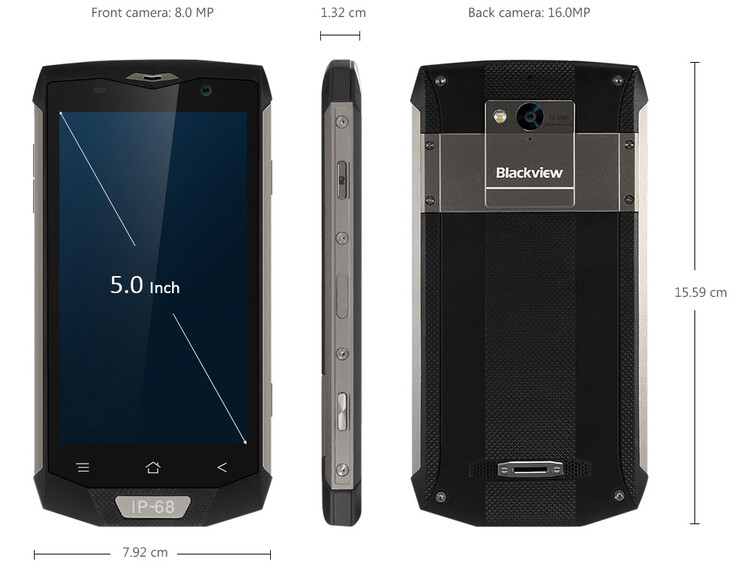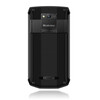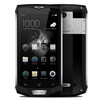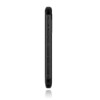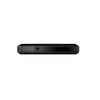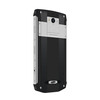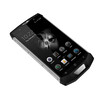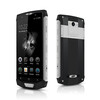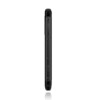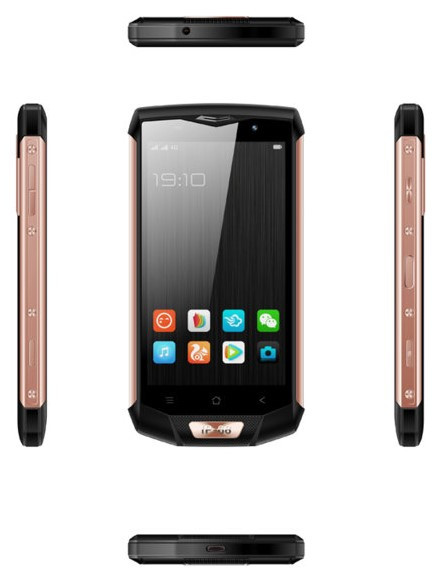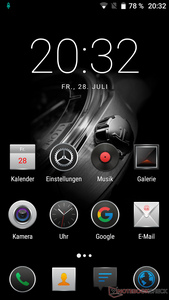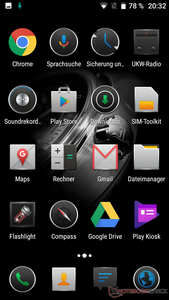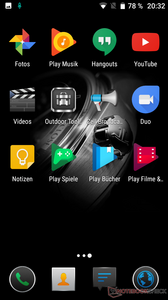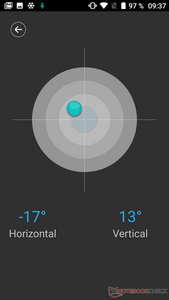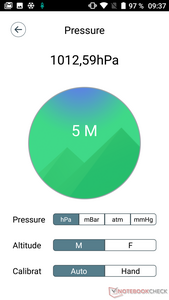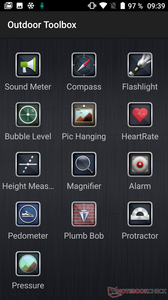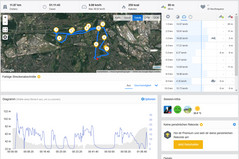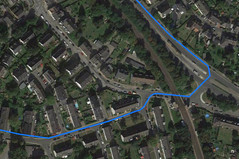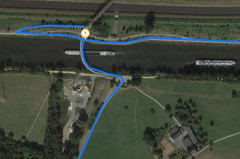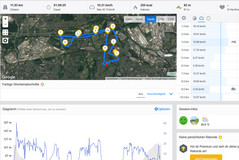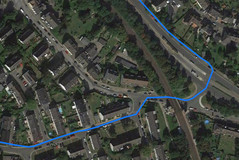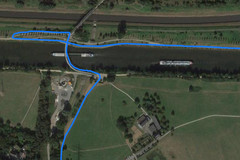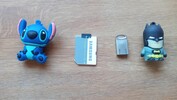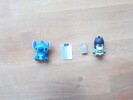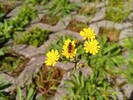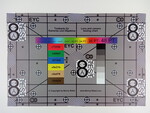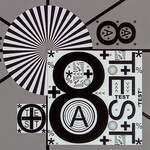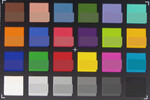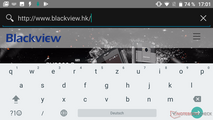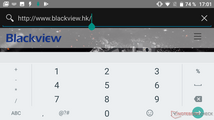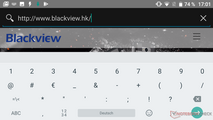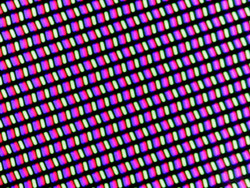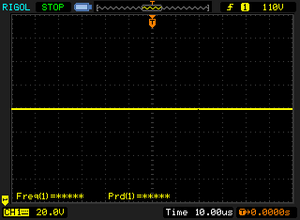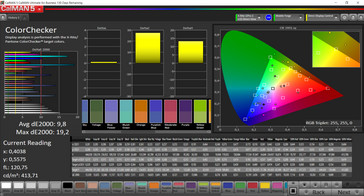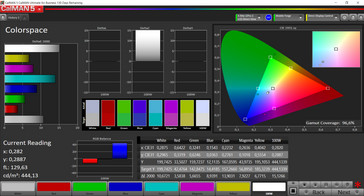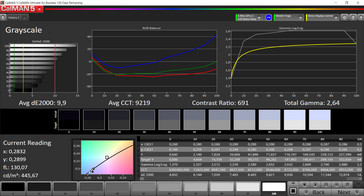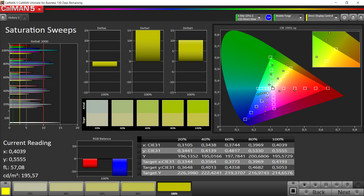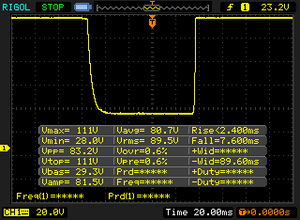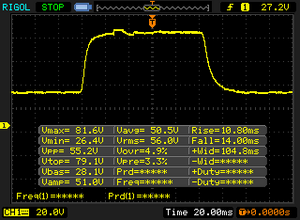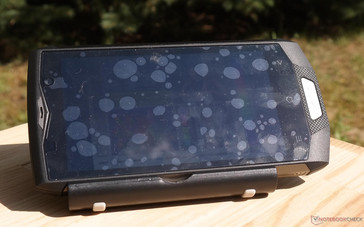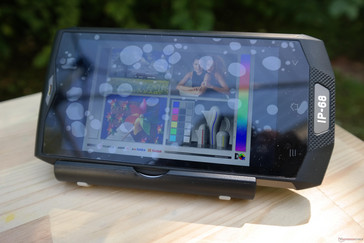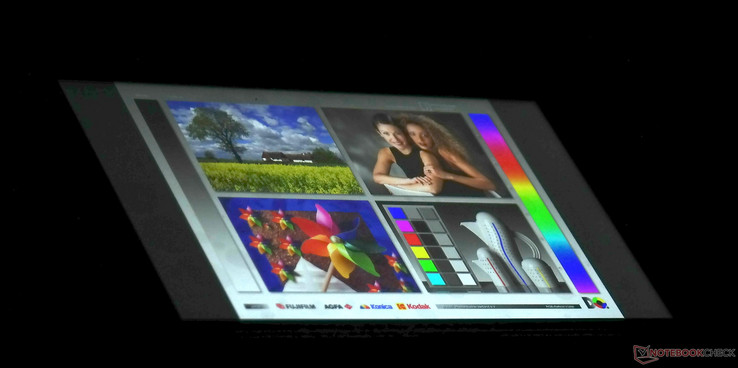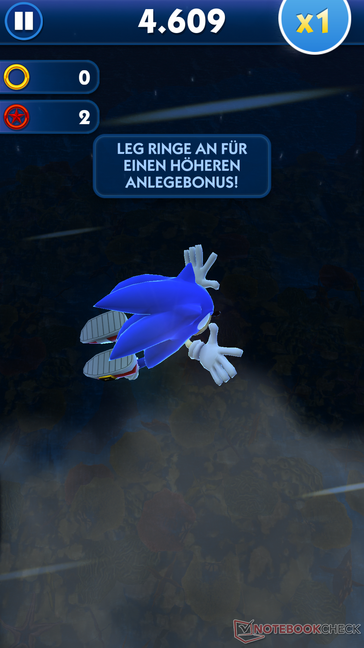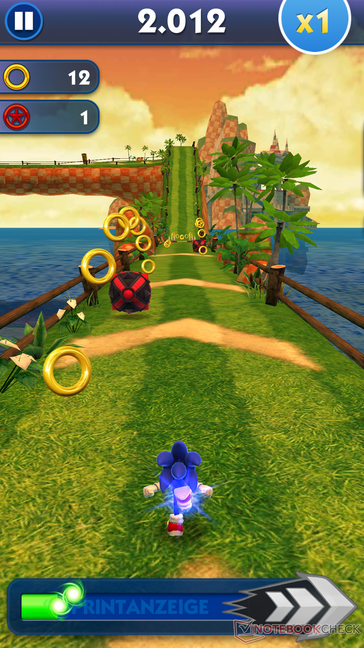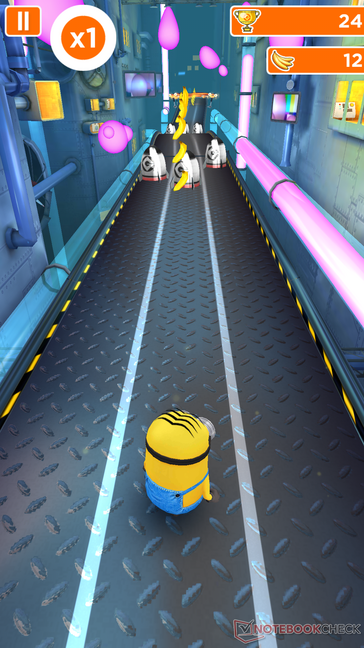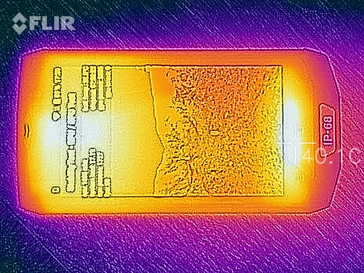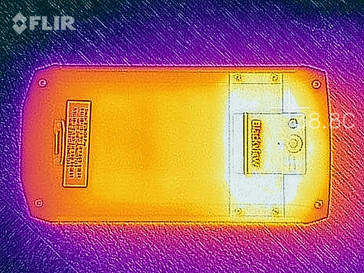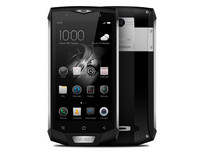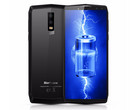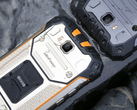Blackview BV8000 Pro Smartphone Review

For the original German review, see here.
These include a built-in compass and a barometer. Compared to the more affordable devices of the series, there is also a slightly more powerful processor, the Mediatek MT6757. All in all, Blackview offers sufficient features for the money here. However, the features that look good on paper are not quite as good in practice.
(The Blackview BV8000 Pro is available in the US from $250.) When buying a smartphone from the Far East, we point to the customs and CE certification regulations and the warranty laws.
The list of the outdoor smartphones that we have tested is growing slowly. As comparison devices, the Nomu S30, the AGM A8, the Samsung Galaxy XCover 4, and the Archos 50 Saphir are available. Even though the prices for the comparison devices are in a similar range, the hardware features vary significantly.
Case
The case appears beefy and robust. Instead of hiding the tiny screws, there are many relatively large, visible screws in the case, which adds to the impression of a very sturdy device in the eye of the beholder. This visual impression is also confirmed by the reality. Even when using a lot of force, the case cannot be bent by hand. The flap that covers the SIM card and microSD slots is secured by 4 screws. A screwdriver is included. As expected, the weight is quite high, and the battery is also not removable.
The device cannot be impressed by a fall from a height of 1.5 m (~5 ft), surviving it without any damage. It can also be washed under the faucet while being turned on.
Features
Blackview relies on a Mediatek MT6757 CPU with 8 cores here. This is about twice as fast as the chips used in Blackview's affordable devices (mostly the MT6737), so it is about on par as the Samsung Galaxy Note 3 which was considered a high-end device three years ago. The CPU is accompanied by an ARM Mali-T880 MP2 GPU, which fits well to the processor in the comparison. 6 GB of RAM and 64 GB of memory storage should also satisfy most desires.
In terms of the connections, the BV8000 Pro appears rather conservative. A USB Type-C connection serves as the charging and data port. Unfortunately, it cannot be used with a regular cable, since the plug has to be inserted very deep into the port. Only the included cable or adapter can be used. Furthermore, the connection supports OTG functionality and can also charge other devices. On the opposite end is a headphone connection. Since the port is also inserted deeply into the case, you have to use the included earphones as well. On the right side, next to the power button is a separate key for taking photos and in between them is a fingerprint sensor. The unusual placement and form means that it might be missed altogether, since it looks like the SIM card slots in the other Blackview devices. On the opposite side, there are the volume rocker and an additional key in the bottom half, which can be individually assigned.
Software
With Android 7.0, Blackview uses a quite current version of Google's operating system. As customary for this manufacturer, there is no separate app drawer here either. As in the iPhone, the apps are placed directly on the Home screen. Furthermore, the icons of some standard apps have received a "Metallic" look from Blackview. In some menus, the icons have been changed in this way as well. While this looks okay on the Home screen in its original state, it looks slightly out of place in the Settings, for example. If more apps are added, they will not have the adjusted looks.
In terms of additional software, Blackview is restrained as usual. There are hardly any advertising apps. Instead, there is an "Outdoor Toolbox," which contains some useful tools for craftsmen and outdoors enthusiasts. These include a level and an altitude gauge. The smartphone also offers its support when hanging pictures, but unfortunately that does not always work perfectly.
We also see some negative points in the software. For example, the screen often displayed an ant race, which we initially thought was a defect of the screen. However, the problem only occurs when playing movies and 3D apps. After performing an update (yes, Blackview really offers regular updates for its devices), the problem seemed to occur less frequently, apparently only when playing videos. Afterwards the device had another problem, but more on that in the relevant section later.
Communication and GPS
While the BV8000 Pro is ahead of most of its competitors in terms of WLAN speed, it remains behind the Nomu S30. Its speed of about 100 MBit/s is no new record, but rather meager. The current iPhone 7 or Samsung's Galaxy S8 achieve about five times the speed here. However, for surfing on the Internet, the speed is still sufficient, since most internet connections are not faster than that anyway. Higher speeds would only be useful when streaming from local devices (such as a NAS).
From time to time, there were drops when using the WLAN. This might be due to a reduced range or interference signals, although this was rather rare.
In contrast, the covered LTE frequencies are quite impressive. Except for band 7 at 2600 MHz, all the frequencies used in Germany are supported.
If you remove the BV8000 Pro's back plate which is secured with Philips screws, you can see three card slots. You can insert two Nano-SIM cards for the dual-SIM function and one microSD card at the same time.
| Networking | |
| iperf3 transmit AX12 | |
| Nomu S30 | |
| Blackview BV8000 Pro | |
| Archos 50 Saphir | |
| Samsung Galaxy XCover 4 | |
| AGM A8 | |
| iperf3 receive AX12 | |
| Nomu S30 | |
| Blackview BV8000 Pro | |
| Samsung Galaxy XCover 4 | |
| Archos 50 Saphir | |
| AGM A8 | |
The GPS reception is compelling, however. Shortly after turning it on, the "GPS Test" app shows an accuracy of 3 meters (~10 ft). Other devices have an accuracy of 5 to 6 meters (~16 to ~20 ft) here. Not only GPS, but also GLONASS is used. Although the reception indoors was worse, an accuracy of 3 meters (~10 ft) was confirmed here as well. If this is correct, it even exceeds the Galaxy S8, which additionally consults Chinese and European satellites.
The images of our test route show that the accuracy is almost on par with our Garmin Edge 500 reference device. Even if the position is not queried quite frequently, the route is almost identical. This basically confirms the observations of GPS Test, that we have a very accurate location sensor here.
Telephone and Call Quality
As usual, Blackview uses Android's standard Telephone app. Only a few icons have changed, which does not fit quite as well into the remaining design. It is not clear why Blackview is doing this. During phone calls, there were no problems, though. Our conversation partner was clearly understandable, and there was no noise or distortion. The caller on the Blackview could also be understood easily by our conversation partner. Surrounding noises were also suppressed. Overall, the BV8000 Pro showed a flawless performance here. The included earphones are slightly better than those of other Blackview devices.
Cameras
As in its other devices, Blackview also relies on Samsung parts for the built-in camera here. For the main camera, a model with the label S5K4H8 and 16 Megapixels is used. For selfies, the S5K3P3 – also by Samsung – is used.
The behavior of the main camera offered some puzzles. While we could still take decent pictures from any distance before the update, after the update the lens did not want to focus over distances further than 2 meters (~6.5 ft) anymore, and the pictures were basically unusable. Other camera apps did not help here either. However, we were able to take some excellent close-ups. As mentioned before, this appears to be a software issue, and we hope that Blackview can correct this problem.
In general, the color reproduction can be described as acceptable. Many colors are reproduced accurately, but others deviate significantly, as can be seen in the ColorChecker. Quite a strong red tint is noticeable, and overall most pictures appear slightly dark. The sharpness is quite impressive though - if only there was not the problem with distances.
However, the selfie camera is clearly worse. While the colors are mostly okay, the sharpness is less satisfactory. At 8 Megapixels, there should clearly be more.
Overall a mixed performance: not really good but somehow not really bad either. Our hope remains that something can be improved by the software. The hardware seems to provide the necessary performance.
Color accuracy and sharpness are generally very good, except for some noticeable outliers in the red color range.
Accessories and Warranty
Blackview includes several accessories. Beginning with an additional display cover and continuing with earphones and an OTG cable, all are included in the standard accessories. The cable and earphones are designed especially for the BV8000 Pro, because it has considerably deeper port openings. This can probably be traced back to the IP-68 specifications. To be able to use another USB cable, a small adapter that extends the Type-C jack is included. However, it might be difficult to plug in another headset. In order to insert the SIM card and microSD card, 4 screws have to be loosened on the back, for which the appropriate Philips screwdriver is included. The rest of the device is held together by Torx screws, so that there can be no confusion. A case is not included in the package. Other Blackview devices come with a standard transparent case. Blackview offers no further accessories at this point. The manufacturer also offers no warranty, but some Chinese shops offer returns. Please see our Guarantees, Return policies and Warranties FAQ for country-specific information.
Input Devices and Operation
By default, the BV8000 Pro uses the Gboard keyboard. This is an extended keyboard, which also allows quick switching between the German and English layout. In addition, it offers the option to activate the number pad for fast number input. Besides the additional options, it uses the standard layout. The operation of the 5-finger touchscreen is unremarkable. It reacts sufficiently fast, and the surface also has good sliding characteristics.
However, on a negative point we should point out that Blackview has applied the protective foil sloppily to the display of our test unit. As you can see in the pictures, it is covered with bubbles and therefore had to be removed immediately.
Display
A 5-inch IPS panel with a resolution of 1920x1080 pixels is used as the display. You should not count expect InfinityEdge or similar gimmicks here. The display is enveloped by the beefy frame of the device. It has the classical 16:9 format and a pixel density of 441 PPI. With this, you should not be able to see any pixels when looking closely with your eyes. According to the manufacturer, it is protected by Corning Gorilla Glass 3. Whether this is sufficient for an outdoor smartphone, our crash test will show.
It is a rather average device in the comparison. The brightness is sufficient, but could be slightly better in view of the outdoor target audience.
| |||||||||||||||||||||||||
Brightness Distribution: 86 %
Center on Battery: 434 cd/m²
Contrast: 678:1 (Black: 0.64 cd/m²)
ΔE ColorChecker Calman: 9.8 | ∀{0.5-29.43 Ø4.77}
ΔE Greyscale Calman: 9.9 | ∀{0.09-98 Ø5}
Gamma: 2.64
CCT: 9219 K
| Blackview BV8000 Pro IPS, 1920x1080, 5" | Nomu S30 IPS, 1920x1080, 5.5" | AGM A8 IPS, 1280x720, 5" | Archos 50 Saphir IPS, 1280x720, 5" | Samsung Galaxy XCover 4 IPS, 1280x720, 5" | |
|---|---|---|---|---|---|
| Screen | 31% | 49% | -1% | 14% | |
| Brightness middle (cd/m²) | 434 | 423 -3% | 356 -18% | 545 26% | 445 3% |
| Brightness (cd/m²) | 414 | 421 2% | 343 -17% | 527 27% | 437 6% |
| Brightness Distribution (%) | 86 | 93 8% | 93 8% | 87 1% | 88 2% |
| Black Level * (cd/m²) | 0.64 | 0.26 59% | 0.21 67% | 0.58 9% | 0.67 -5% |
| Contrast (:1) | 678 | 1627 140% | 1695 150% | 940 39% | 664 -2% |
| Colorchecker dE 2000 * | 9.8 | 7.8 20% | 3.7 62% | 12.5 -28% | 6.5 34% |
| Colorchecker dE 2000 max. * | 19.2 | 14.5 24% | 8.3 57% | 24.4 -27% | 10.6 45% |
| Greyscale dE 2000 * | 9.9 | 9.8 1% | 1.9 81% | 15.4 -56% | 7.2 27% |
| Gamma | 2.64 83% | 2.32 95% | 2.5 88% | 1.87 118% | 2.53 87% |
| CCT | 9219 71% | 9828 66% | 6412 101% | 12705 51% | 8274 79% |
* ... smaller is better
Screen Flickering / PWM (Pulse-Width Modulation)
| Screen flickering / PWM not detected | |||
In comparison: 53 % of all tested devices do not use PWM to dim the display. If PWM was detected, an average of 8084 (minimum: 5 - maximum: 343500) Hz was measured. | |||
The color values we measured are also rather low average. However, the competition is not much better on average. In particular, the more well-known brands such as Samsung and Archos do similarly bad here. Anyone valuing a good screen is better served with the Nomu S30 or the AGM A8.
In terms of contrast in particular, the BV8000 Pro remains far behind. The black value cannot convince either. In addition, there are strong color distortions, particularly in the CalMAN Grayscale chart where a clearly blue tint is visible. The average DeltaE value of almost 10 is also not impressive. Only the Archos Saphir is clearly even worse here.
In daily operation, however, these distortions are hardly noticeable without having a comparison. A graphics professional will probably not purchase an outdoor smartphone for his work anyway.
Display Response Times
| ↔ Response Time Black to White | ||
|---|---|---|
| 10 ms ... rise ↗ and fall ↘ combined | ↗ 2.4 ms rise | |
| ↘ 7.6 ms fall | ||
| The screen shows good response rates in our tests, but may be too slow for competitive gamers. In comparison, all tested devices range from 0.1 (minimum) to 240 (maximum) ms. » 26 % of all devices are better. This means that the measured response time is better than the average of all tested devices (20.2 ms). | ||
| ↔ Response Time 50% Grey to 80% Grey | ||
| 24.8 ms ... rise ↗ and fall ↘ combined | ↗ 10.8 ms rise | |
| ↘ 14 ms fall | ||
| The screen shows good response rates in our tests, but may be too slow for competitive gamers. In comparison, all tested devices range from 0.165 (minimum) to 636 (maximum) ms. » 34 % of all devices are better. This means that the measured response time is better than the average of all tested devices (31.6 ms). | ||
For an outdoor smartphone, brightness and viewing angle stability are much more important than color accuracy. Here the device delivers a solid performance, even if it is not completely convincing. The brightness is on a normal level, but also not particularly high. In case of a desert expedition, the adventurer should rather prepare for night excursions, since during the day, the phone might be hard to read in strong sunlight. In the shade there is no problem, though. The viewing angle stability is also okay, but could be better.
Overall, the values indicate a rather average display: not really bad, but not good either.
Performance
Compared to the competing devices, the Blackview smartphone is very well equipped and trumps the competitors' performance in almost all the benchmarks. Here the wheat is in parts clearly separated from the chaff. Devices such as the Saphir 50, for example, are only equipped with a processor that is half as fast and fall back accordingly. Only the Nomu S30 can half-way keep up here. Yet, in terms of performance, this is not a high-end device. The current top devices are about three times as fast as the BV8000 Pro.
| AnTuTu v6 - Total Score (sort by value) | |
| Blackview BV8000 Pro | |
| Nomu S30 | |
| AGM A8 | |
| Archos 50 Saphir | |
| Samsung Galaxy XCover 4 | |
| PCMark for Android | |
| Work performance score (sort by value) | |
| Blackview BV8000 Pro | |
| Nomu S30 | |
| AGM A8 | |
| Samsung Galaxy XCover 4 | |
| Work 2.0 performance score (sort by value) | |
| Blackview BV8000 Pro | |
| Nomu S30 | |
| AGM A8 | |
| Archos 50 Saphir | |
| Samsung Galaxy XCover 4 | |
| Geekbench 4.4 | |
| 64 Bit Single-Core Score (sort by value) | |
| Blackview BV8000 Pro | |
| AGM A8 | |
| Samsung Galaxy XCover 4 | |
| 64 Bit Multi-Core Score (sort by value) | |
| Blackview BV8000 Pro | |
| AGM A8 | |
| Samsung Galaxy XCover 4 | |
| Compute RenderScript Score (sort by value) | |
| Blackview BV8000 Pro | |
| GFXBench (DX / GLBenchmark) 2.7 | |
| T-Rex Onscreen (sort by value) | |
| Nomu S30 | |
| AGM A8 | |
| Archos 50 Saphir | |
| Samsung Galaxy XCover 4 | |
| 1920x1080 T-Rex Offscreen (sort by value) | |
| Nomu S30 | |
| AGM A8 | |
| Archos 50 Saphir | |
| Samsung Galaxy XCover 4 | |
| GFXBench 3.0 | |
| on screen Manhattan Onscreen OGL (sort by value) | |
| Blackview BV8000 Pro | |
| Nomu S30 | |
| AGM A8 | |
| Archos 50 Saphir | |
| Samsung Galaxy XCover 4 | |
| 1920x1080 1080p Manhattan Offscreen (sort by value) | |
| Blackview BV8000 Pro | |
| Nomu S30 | |
| AGM A8 | |
| Archos 50 Saphir | |
| Samsung Galaxy XCover 4 | |
| GFXBench 3.1 | |
| on screen Manhattan ES 3.1 Onscreen (sort by value) | |
| Blackview BV8000 Pro | |
| Nomu S30 | |
| Archos 50 Saphir | |
| Samsung Galaxy XCover 4 | |
| 1920x1080 Manhattan ES 3.1 Offscreen (sort by value) | |
| Blackview BV8000 Pro | |
| Nomu S30 | |
| Archos 50 Saphir | |
| Samsung Galaxy XCover 4 | |
| GFXBench | |
| on screen Car Chase Onscreen (sort by value) | |
| Blackview BV8000 Pro | |
| Nomu S30 | |
| 1920x1080 Car Chase Offscreen (sort by value) | |
| Blackview BV8000 Pro | |
| Nomu S30 | |
| Lightmark - 1920x1080 1080p (sort by value) | |
| Samsung Galaxy XCover 4 | |
| Basemark X 1.1 | |
| Medium Quality (sort by value) | |
| Samsung Galaxy XCover 4 | |
| High Quality (sort by value) | |
| Samsung Galaxy XCover 4 | |
| Basemark ES 3.1 / Metal - offscreen Overall Score (sort by value) | |
| AGM A8 | |
| Samsung Galaxy XCover 4 | |
| Epic Citadel - Ultra High Quality (sort by value) | |
| Samsung Galaxy XCover 4 | |
In the browser benchmarks, the results look more differentiated. While the BV8000 Pro defends the top position in the Jetstream and Octane benchmarks, it is astonishingly slow in the Kraken benchmark. This might possibly be better using a Mozilla browser.
| JetStream 1.1 - Total Score | |
| Blackview BV8000 Pro | |
| Nomu S30 | |
| Archos 50 Saphir | |
| Samsung Galaxy XCover 4 | |
| AGM A8 | |
| Octane V2 - Total Score | |
| Blackview BV8000 Pro | |
| Archos 50 Saphir | |
| Nomu S30 | |
| Samsung Galaxy XCover 4 | |
| AGM A8 | |
| Mozilla Kraken 1.1 - Total | |
| Nomu S30 | |
| Blackview BV8000 Pro | |
| AGM A8 | |
| Samsung Galaxy XCover 4 | |
| Archos 50 Saphir | |
| WebXPRT 2015 - Overall | |
| Samsung Galaxy XCover 4 | |
* ... smaller is better
In the measurements of the reading speed of the microSD card, the Blackview is in the middle of the field. However, in the test with our Toshiba Exceria Pro SDXC 64 GB UHS-II reference card, it was able to leave the competitors behind, which are equipped with even slower card readers.
| Blackview BV8000 Pro | Nomu S30 | AGM A8 | Archos 50 Saphir | Samsung Galaxy XCover 4 | |
|---|---|---|---|---|---|
| AndroBench 3-5 | -34% | -67% | -69% | -33% | |
| Sequential Read 256KB (MB/s) | 246.4 | 242 -2% | 140.7 -43% | 140.9 -43% | 181.6 -26% |
| Sequential Write 256KB (MB/s) | 177.1 | 194.9 10% | 69.5 -61% | 12.21 -93% | 73.6 -58% |
| Random Read 4KB (MB/s) | 52.7 | 27.99 -47% | 11.44 -78% | 14.48 -73% | 21.8 -59% |
| Random Write 4KB (MB/s) | 15.05 | 8.84 -41% | 3.73 -75% | 4.79 -68% | 11.9 -21% |
| Sequential Read 256KB SDCard (MB/s) | 79.3 | 36.94 -53% | 22.01 -72% | 28.55 -64% | 69 -13% |
| Sequential Write 256KB SDCard (MB/s) | 68.7 | 21.52 -69% | 20.46 -70% | 18.3 -73% | 55.7 -19% |
Games
The graphics solution of the BV8000 Pro is an ARM Mali-T880 GP2 chip, which reaches moderate speeds and allows smooth playing of even more demanding 3D games such as "Asphalt 8."
Compared to the competition listed here, the Blackview smartphone should achieve the top position without any trouble. Most of the games in the Play Store should not give any problems. Yet, it should be clear that there are considerably more powerful graphics solutions and that the device is only in the middle of the field here.
The touchscreen and the position sensor also react quickly.
Emissions
Temperature
(+) The maximum temperature on the upper side is 37.6 °C / 100 F, compared to the average of 35.2 °C / 95 F, ranging from 21.9 to 247 °C for the class Smartphone.
(+) The bottom heats up to a maximum of 38.2 °C / 101 F, compared to the average of 34 °C / 93 F
(±) In idle usage, the average temperature for the upper side is 35.1 °C / 95 F, compared to the device average of 32.9 °C / 91 F.
Speakers
In comparison, the built-in speaker can be described as quite solid. It can play very loud and covers the sound spectrum quite well. Only the bass is lacking as usual. The included earphones appear to be slightly better than what Blackview usually includes. However, connecting other speakers or headphones turns out to be difficult, since the audio connection is set into the case deeper than usual and therefore a longer plug is needed.
Blackview BV8000 Pro audio analysis
(+) | speakers can play relatively loud (92 dB)
Bass 100 - 315 Hz
(-) | nearly no bass - on average 28.2% lower than median
(+) | bass is linear (4% delta to prev. frequency)
Mids 400 - 2000 Hz
(±) | reduced mids - on average 5.3% lower than median
(+) | mids are linear (6.2% delta to prev. frequency)
Highs 2 - 16 kHz
(+) | balanced highs - only 2.4% away from median
(+) | highs are linear (2.7% delta to prev. frequency)
Overall 100 - 16.000 Hz
(±) | linearity of overall sound is average (18.6% difference to median)
Compared to same class
» 21% of all tested devices in this class were better, 9% similar, 70% worse
» The best had a delta of 11%, average was 35%, worst was 134%
Compared to all devices tested
» 41% of all tested devices were better, 8% similar, 51% worse
» The best had a delta of 4%, average was 24%, worst was 134%
Samsung Galaxy XCover 4 audio analysis
(±) | speaker loudness is average but good (80.4 dB)
Bass 100 - 315 Hz
(-) | nearly no bass - on average 15.9% lower than median
(±) | linearity of bass is average (12.3% delta to prev. frequency)
Mids 400 - 2000 Hz
(±) | higher mids - on average 7.4% higher than median
(+) | mids are linear (5.1% delta to prev. frequency)
Highs 2 - 16 kHz
(±) | higher highs - on average 6.3% higher than median
(+) | highs are linear (6.3% delta to prev. frequency)
Overall 100 - 16.000 Hz
(±) | linearity of overall sound is average (24.2% difference to median)
Compared to same class
» 56% of all tested devices in this class were better, 7% similar, 36% worse
» The best had a delta of 11%, average was 35%, worst was 134%
Compared to all devices tested
» 72% of all tested devices were better, 6% similar, 22% worse
» The best had a delta of 4%, average was 24%, worst was 134%
Frequency comparison (Checkboxes selectable!)
Battery Life
Power Consumption
In terms of power consumption, the BV8000 Pro does surprisingly well during idle operation. The power consumption is almost the traditional weakness of the Chinese smartphones. In this comparison, the Blackview device is on top in the average consumption. Even under load, the average values are slightly better than the competition. This is an important plus for the device.
| Off / Standby | |
| Idle | |
| Load |
|
Key:
min: | |
| Blackview BV8000 Pro 4180 mAh | Nomu S30 5000 mAh | AGM A8 4050 mAh | Archos 50 Saphir 5000 mAh | Samsung Galaxy XCover 4 2800 mAh | |
|---|---|---|---|---|---|
| Power Consumption | -18% | -10% | -11% | 9% | |
| Idle Minimum * (Watt) | 0.85 | 0.93 -9% | 0.86 -1% | 0.65 24% | 0.56 34% |
| Idle Average * (Watt) | 1.56 | 2.31 -48% | 1.97 -26% | 1.9 -22% | 1.57 -1% |
| Idle Maximum * (Watt) | 1.67 | 2.35 -41% | 2.04 -22% | 2.05 -23% | 1.68 -1% |
| Load Average * (Watt) | 4.37 | 4.57 -5% | 4.86 -11% | 6.14 -41% | 4.6 -5% |
| Load Maximum * (Watt) | 7.06 | 6.1 14% | 6.43 9% | 6.54 7% | 5.92 16% |
* ... smaller is better
Battery Life
The outdoor smartphone also cuts an astonishingly good figure in the battery life. It can even pass the Samsung device, which, we have to mention to be fair, has a considerably smaller battery. However, the BV8000 Pro can also keep up well with the remaining participants in our competition, which have a slightly larger battery. A relatively long battery life is important for a device that you may take on a hike or the construction site. While the Blackview device does not set any new records here, it fares appropriately well.
| Blackview BV8000 Pro 4180 mAh | Nomu S30 5000 mAh | AGM A8 4050 mAh | Archos 50 Saphir 5000 mAh | Samsung Galaxy XCover 4 2800 mAh | |
|---|---|---|---|---|---|
| Battery runtime | 21% | -5% | 41% | -24% | |
| Reader / Idle (h) | 26.3 | 23.1 -12% | |||
| WiFi v1.3 (h) | 11.5 | 13.9 21% | 10.9 -5% | 16.2 41% | 11.1 -3% |
| Load (h) | 7.9 | 3.4 -57% | |||
| H.264 (h) | 11.4 |
Pros
Cons
Verdict
We can describe the BV8000 Pro as a big step for Blackview. Not only because the Chinese manufacturer offers probably the best-equipped outdoor smartphone here (besides the Caterpillar with an infrared camera) for a relatively low price, but also since some problems of the other devices have also been fixed. Blackview often struggles with high power consumption and the resulting meager battery life. The BV8000 Pro masters this obstacle quite well. There is also nothing to complain about the performance and workmanship. The fast and accurate GPS fits well to the target audience of the device.
Balanced overall package with a very good price-performance ratio, but ugly software errors.
However, Blackview commits some new blunders here, which we have not seen in previous tests. The software appears to have considerable errors. First, there are the ant races which flicker across the screen from time to time, mainly while watching videos. And second, after the update, a previously decent camera is unable to focus in the distance. Even though the Outdoor-Tools included in the software look quite interesting, they do not always work reliably, which makes them useless. Therefore we must reduce the overall evaluation by 2% as long as Blackview does not fix these problems.
The good news is that these are probably simply software problems. Since Blackview offers updates from time to time, such problems might still be solved. Then the telephone would definitely deserve a recommendation.
Blackview BV8000 Pro
- 08/08/2017 v6 (old)
Florian Schaar




